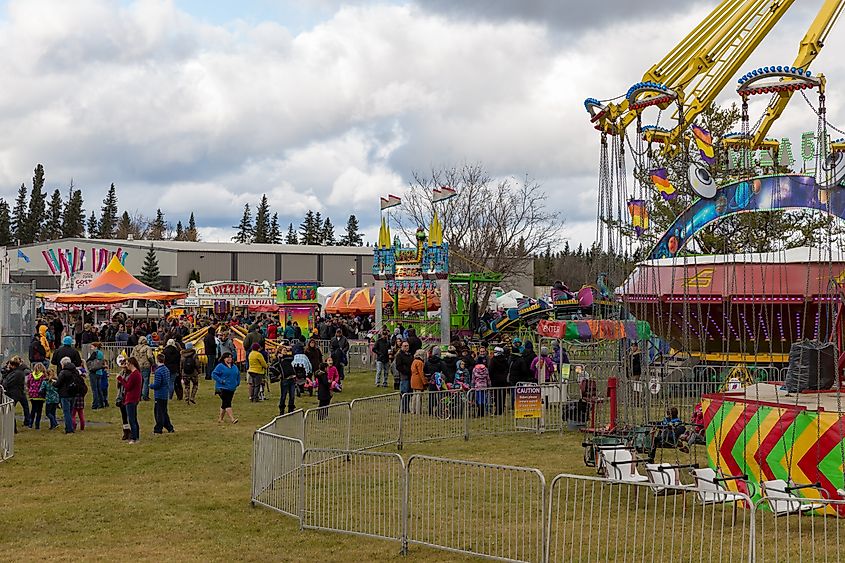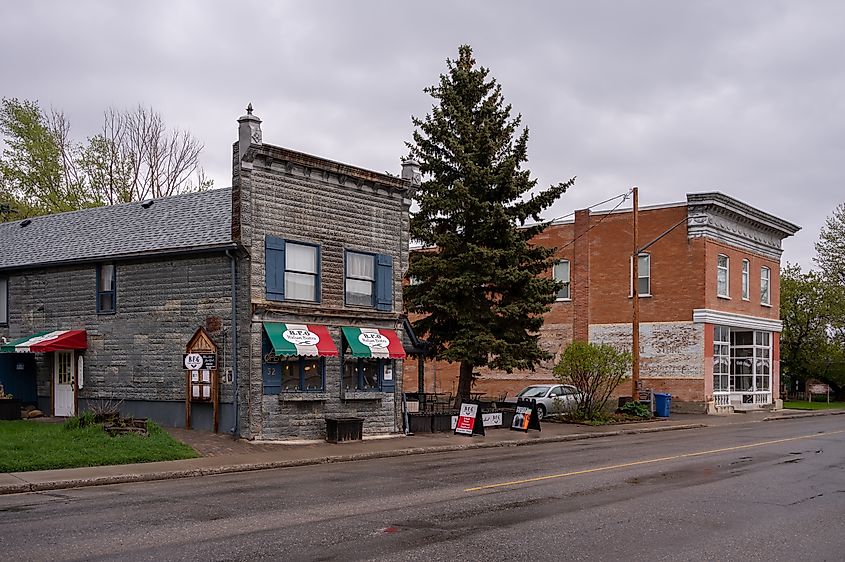
7 Offbeat Towns to Visit in Alberta
Alberta is one of the ten provinces in Canada and the fourth-largest and most landlocked of them all. It was named after Princess Louise Caroline Alberta, the fourth daughter of Queen Victoria and Prince Albert, and has been the home of the First Nations, the Inuit, and the Metis for thousands of years. Amidst the towering mountains and lush woodlands of a province that receives the most direct amount of sunlight anywhere in Canada, you can get lost in the many wandering roads and paths snaking through these untamed lands. But in your listless roving, you might just find the most offbeat towns to visit in Alberta, each a hidden paradise in the many national parks and landscapes of the province.
Smoky Lake

Approximately 72 miles from the city of Edmonton, Smoky Lake is one of the hottest attractions on the offbeat roads of Alberta. Located between the North Saskatchewan River, Smoky Creek, and White Earth Creek, travelers will be amazed by the vast agricultural fields and bounties produced by Smoky Lake. The most notable of produce happens to be pumpkins, and because Smoky Lake is the Pumpkin Capital of Alberta, you can attend the annual Great White North Pumpkin Weigh-off & Fair on October 5.
The etymology of the town’s name has been debated for years, but currently, there are two main theories about its origins. One, Smoky Lake, comes from the “Smoking Lake” name given by the Cree First Nations people, who live near a lake whose surface haze looks like rising smoke. The second theory is that the Cree called the area “Smoking Place” because they often gathered at a spot near the lake to smoke pipes during their hunts. If you're interested in learning more about Smoky Lake’s indigenous cultures or its history of growth from early fur traders, you can visit the Smoky Lake Museum. Surprisingly, Smoky Lake was even featured in Ripley’s Believe it or Not for having the highest number of businesses per capita in Canada.
Banff

Alberta is renowned for its fresh and vibrant Canadian wilderness. In the town of Banff, situated in Bow River, travelers will be enchanted by the lush woodlands and mountains of Banff National Park. These 4,040 square miles of parkland have been designated a UNESCO World Heritage Site in Canada, and are home to elk, grizzly bears, wolves, and more of Alberta’s wildlife. Canada’s first national park, the Cave and Basin National Historic Site houses many hot mineral pools for your leisure.

Tourists can learn all about Banff’s indigenous cultures and early settlers at the Whyte Museum of the Canadian Rockies and the Banff Park Museum National Historic Site. Trailblazers might want to ascend the slopes of Mt. Rundle and Mt. Cascade, both of which are part of the Rocky Mountains; you can also take a dip at Lake Minnewanka. You should definitely take the Banff Gondola all the way up to Sulphur Mountain, where you can see the Sulphur Mountain Cosmic Ray Station National Historic Site—a former geophysics laboratory from 1957. You might also fancy delving into the Sundance Canyon for excellent photographs of the forests and mountains of the Banff National Park.
Jasper

Jasper, situated on the Athabasca River in the Athabasca Valley, is a close rival and equal to Banff when it comes to being the best national park in Alberta. As the alpine and commercial center of the Jasper National Park, Jasper’s region of the Canadian Rockies is filled with lakes and rivers all fed by glaciers to the north. There are also the bubbling and enticing sprays from the Athabasca Falls. From the summit of Whistlers Mountain—accessible via The Jasper SkyTram—visitors are greeted by dynamic views of Jasper and its magnificent environments. Meanwhile, at the Jasper Yellowhead Museum and Archives, one can enjoy exhibits representing the fur trade, industrial railways, and early exploration of the Jasper National Park. Most importantly, from October 18 to November 3, you can participate in Jasper’s Dark Night Sky Festival when the evenings are at their cleanest and brightest to see the Milky Way Galaxy.
Canmore

You can do more of all your favorite activities in Canmore, a mountainous town an hour west of the city of Calgary. Canmore comes from the Gaelic word "Ceann Mór," which either means "big head," "great head," or "chief" as a reference to King Malcolm III of Scotland. A trinity of craggy and foreboding mountains dominate Canmore’s skylines—the Three Sisters Peak, Mt. Lawrence Grassi, and Ha Ling Peak. Trekkers will be pumped and challenged by the sinuous Grassi Lakes Trail, which leads to the Canmore Nordic Centre Provincial Park in addition to the sublime waterfall of Grassi Falls and a duo of turquoise-blue lakes.

The Canmore Nordic Centre Provincial Park also promotes mountain biking and cross-country skiing for the more adventurous of travelers. Spelunkers can enter a cave in the limestone-lined walls of the Grotto Canyon, which also contains pictographs of the Stoney-Nakoda nations who once called Canmore "Chuwapchipchiyan Kudi Bi" ("shooting at the willows"). You might also enjoy seeing more of Alberta's biodiversity at the Bow Flats Natural Area. There are several splendid spots for picture-taking, such as the Lac Des Arc Viewpoint, the Grotto Canyon Icefall, and Spray Lakes View Point.
Drumheller

About an hour and a half northeast of Calgary, Drumheller is a dream destination for dinosaur enthusiasts. One of the largest collections of dinosaur fossils can be seen at the Royal Tyrrell Museum in Midland Provincial Park, while Drumheller’s downtown features the “World’s Largest Dinosaur”—a giant model Tyrannosaurus Rex with an observation deck inside its open jaws. There is even Barney’s Adventure Park, although it mainly showcases prehistoric dinosaurs rather than having any connection to the purple dinosaurs from our imagination. If you want to travel back in time, visit the Atlas Coal Mine National Historic Site, whose ancient coal mines significantly contributed to Drumheller and other towns’ development in Alberta. And if you want to feel as if you’re on a strange, alien planet on Earth, explore the Willow Creek Hoodoos with their unique rock formations and towering pillars.
Okotoks

Okotoks is a quaint bedroom community a few miles south of Calgary. Situated around the flowing clean waters of the Sheep River, Okotoks is named after a pair of large quartzite monoliths named Big Rock or "Okotok" by the Blackfeet people. These boulders are part of the Foothill Erratic Train, which includes thousands of uniquely composed quartzite that extends for 580 miles from the Rocky Mountains. Much smaller rocks and minerals aside from quartzite can be perused at the Big Rock Crystals, Minerals & Fossils. Those with palpable tastebuds can feel enlightened and overjoyed at the Chinook Honey Company & Chinook Arch Meadery, while golfers will certainly adore the dozens of golf courses and parks all over Okotoks.
Bragg Creek

Not to brag, but Bragg Creek is one of the best hamlets and destinations in Alberta. Lounging at the confluence of the Elbow River, Bragg Creek contains many award-winning trails and treks that weave through the Kananaskis, an improvement district in the Canadian Rockies. It was founded by two brothers, Albert Warren Bragg and John Thomas Bragg, who wanted to conduct some old-fashioned cowboy ranching in the late 1800s.
One of the few buildings that has remained unchanged over the decades is the Bragg Creek Trading Post, which served as a trading hub between Bragg Creek’s early settlers and the Nakoda First Nation (also known as the Stoney Tribe). Since Bragg Creek is a popular resort and vacation destination for those seeking the relaxed atmosphere of the Canadian Rockies, Bragg Creek Provincial Park offers a wonderful spot for relaxation. You can also go along the Elbow River and capture photos of the stunning cascades at Elbow Falls.
Each quirky town in Alberta showcases the state's geographic wonders and cultural character through its many national parks and attractions. Banff and Jasper, for example, highlight the expansive and untamed landscapes of Banff National Park and Jasper National Park, respectively. Okotoks is a favorite spot for golfers and vacationers seeking relaxation away from Calgary's hustle, while Drumheller excites paleontologists and prehistoric enthusiasts alike. Despite their remote and offbeat locations away from typical travel routes, these small Alberta towns are worth visiting for the peaceful beauty of the Canadian wilderness.











